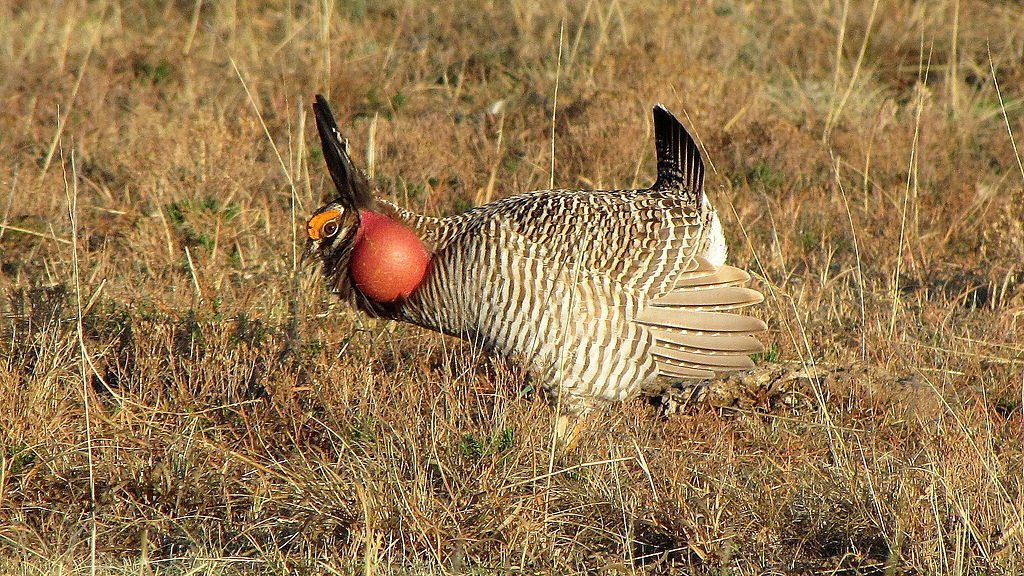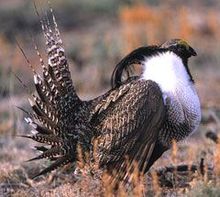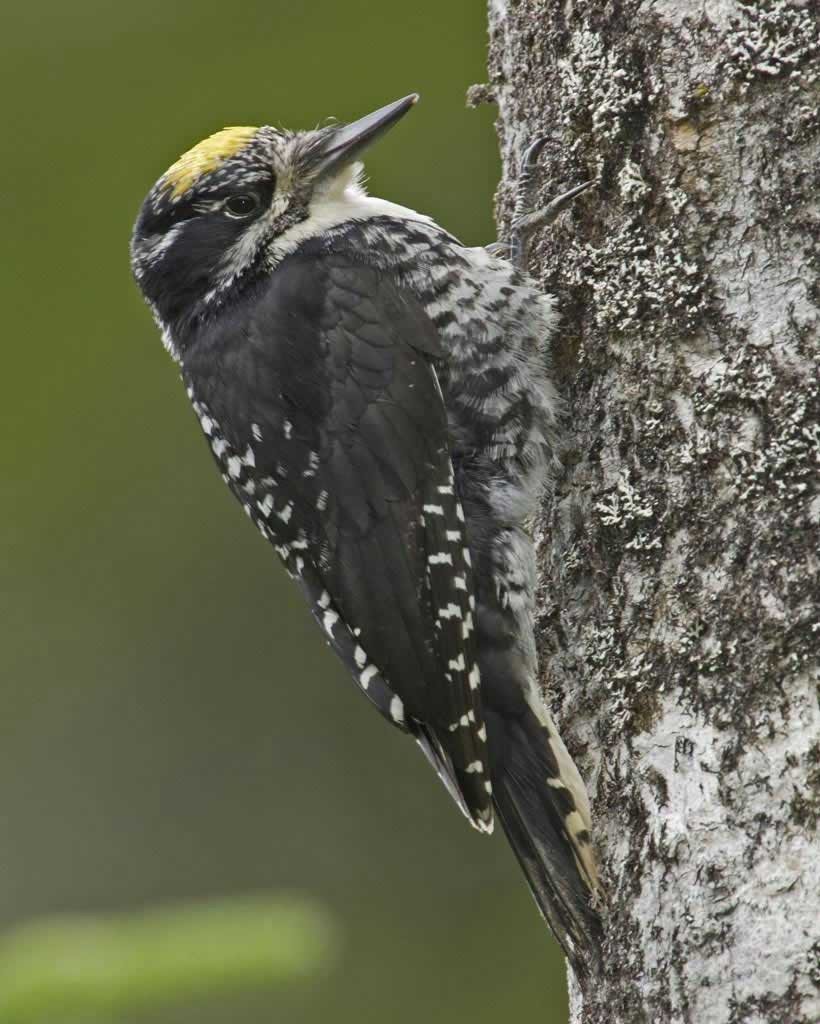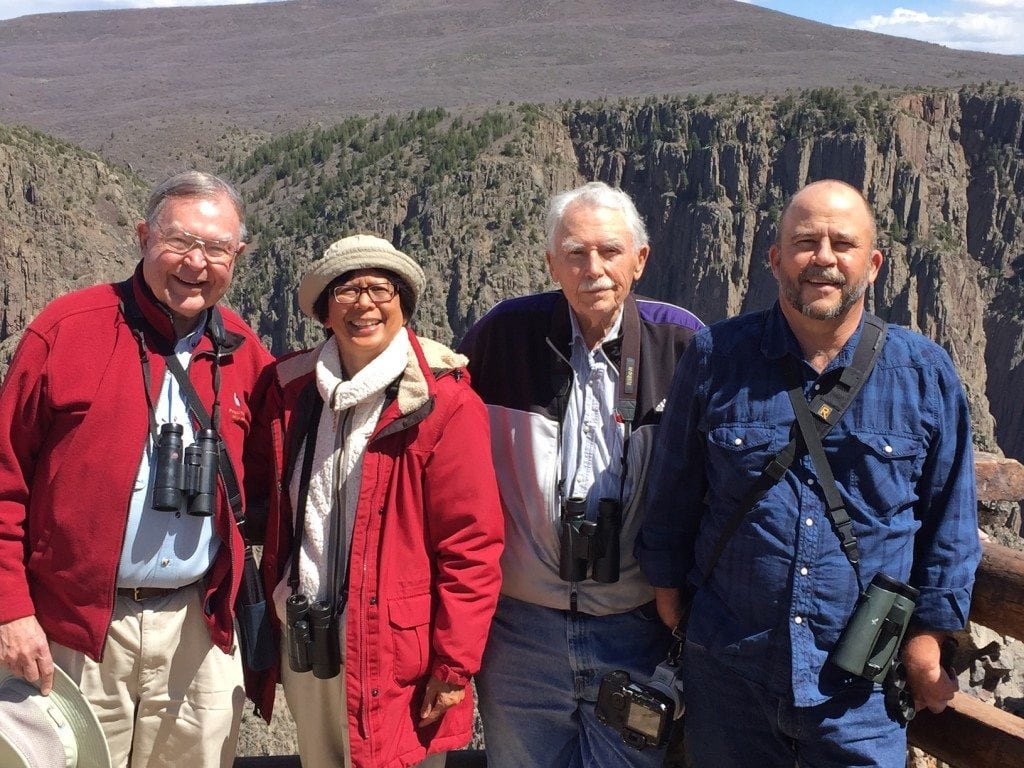“Chicken” searching in Colorado
Note: This is the fifth in a series of occasional blog posts by GGBA member George Peyton about his other half Lani Rumbaoa’s effort to see over 600 bird species in the Lower 48 states in 2015.
By George Peyton
Imagine getting up most mornings between 3 and 4 a.m. to go see “chickens” doing their thing out in very cold weather – followed by long days of birding for nine straight days. That is a good description of the Colorado Grouse Tour organized by High Lonesome BirdTours and extremely well led by Kip Miller and Brett Ewald, which Lani and I were fortunate to join in early April.
In fact, we saw eight separate species of “chickens”, including Greater Prairie-Chicken, Lesser Prairie-Chicken, Gunnison’s Sage-Grouse (rare and an endangered species), Greater Sage-Grouse (the same as seen near Susanville on Golden Gate Bird Alliance’s March field trip), Sharp-tailed Grouse, Chukar, Dusky Grouse, and White-tailed Ptarmigan.
Our first early morning out to see Greater Prairie-Chicken was on Bledsoe Ranch, a huge private ranch of 64,000 acres or 100 square miles, with over 100 separate Greater Prairie-Chicken Leks. We left our motel very early in our two vans, parked right next to the Lek about 1/2 hour before it became light, and saw more than 35 Greater Prairie-Chickens, some within 25 to 30 feet of our vans.
It was an amazing show watching the males do their mating displays and dances, reminding me of some Native American dances that were in fact patterned after the “Chicken Dances.” It was quite cold: I was wearing three separate pairs of long underwear, two of which I wore at Everest Base Camp in 1985, plus 3 layers of coats, and I still shivered a bit.


The next morning we were up again extremely early, and after driving over a half hour in the dark, transferred to a yellow school bus and drove a good bit of time out to a Lek where there were only three Lesser Prairie-Chicken males performing. (This species is being considered for Threatened or Endangered Listing.) We sat in the bus for around 45 minutes in the dark and cold with the windows open before we could make out the forms of the Lesser Prairie-Chickens displaying further away than the previous day.
The following morning we left our motel in Gunnison, Colorado, at 4 a.m. and drove to see the rarest of the “chickens,” the endangered Gunnison’s Sage-Grouse. We sat on bleachers in a small building with the front open to the freezing cold, being absolutely quiet in the dark for over 45 minutes until our scopes alllowed us to make out over 300 yards away six male Gunnison’s Sage-Grouse performing at the top of a ridge.


I know that this sounds like a lot of suffering to see a few birds, but these are for the most part extremely difficult-to-see species, most of which require special arrangements to get on private property or highly restricted public property. Adding these species to Lani’s Big Year List was important to her having a chance to reach her goal of seeing 600 bird species during 2015.
Some other “chickens” were a bit easier to see. Our group drove to Loveland Pass (11,990 feet) early in the morning, got out of our vans, walked 50 yards, and spotted two gorgeous all-white White-tailed Ptarmigans in the snow about fifty yards away (very good scope views). Then in Black Canyon of Gunnison National Park after a picnic lunch in the campground, we found a Dusky Grouse (the Rocky Mountain version of our West Coast Sooty Grouse) sitting absolutely still on the ground under a picnic table, which we were able to study for some time at close range. Sharp-tailed Grouse were performing right beside a rural highway, and we simply pulled our vans off the road in the dark and, after it became light, we watched them perform their dances, sometimes as close as 40 to 50 feet away.
To see all of these “Chickens” our group drove over 2,000 miles, staying in a different motel every night. For such an arduous 8-1/2 days of birding, Hi Lonesome Birdtours made life as easy as possible under the circumstances. We had two comfortable 14-passenger vans with only seven tour members in each van. Our motels were for the most part very nice, and our dinners were also generally quite good. Usually we had an hour and a half or more for breakfast and packing after we returned from our early morning Chicken Lek forays.
We also saw many other bird species besides “chickens.” After locating the White-tailed Ptarmigan, we drove to a ski home area near Silverthorne, Colorado, where two houses had many bird feeding stations, which attracted all three species of Rosy-finch (Black, Brown-capped, and Grey-crowned ), all of which we saw at close range.
The fact that we were able to see a number of difficult-to-find species such as American Three-toed Woodpecker was due to Kip and Brett, our two superb bird leaders, who not only were excellent at rapidly spotting the birds and getting scopes on them, but made sure that all tour members got a view. I would definitely recommend the Hi Lonesome Colorado Grouse Tour to anyone wanting to see these many special species of “chickens.”

For Lani and me, a very important part of our Colorado Tour was meeting a unique father-and-son team, Monroe and James McKay, who are doing a joint ABA Big Year (including Alaska). The McKays are mostly driving a Toyota Tundra Pickup with an Airstream Trailer towed behind it. Their rule is that both father and son have to see the same species together for it to be counted on their joint Big Year List.
Even more amazing is that Monroe McKay — appointed to the 10th Circuit by Jimmy Carter — is still at 87 years of age working part-time as a judge on the Federal Appellate Court. In addition to telling fascinating and often funny stories and regularly dropping gems of wisdom in his conversation, Judge McKay is amazingly spry and participated fully during our many long days of birding.

James McKay, his son, took early retirement at age 56 from his position as senior supervising attorney at the Federal District Court in Phoenix in order to spend all of 2015 birding, with the plan to resume a legal practice next year. He is the Big Year Planner and a very good birder. He makes a special point of looking after his father, and the two have birded together in various places around the world, including a birding tour last year to Brazil.
Lani and I hoped to see the McKays at one or two places during the remainder of her Big Year including our next destination, the Texas Coast, particularly High Island, the justly famous magnet for Spring Migrants.
Coming out of Colorado, Lani’s Big Year List reached 404 species toward her goal of seeing at least 600 bird species during 2015.
———————————–
Lani Rumbaoa now has seen 510 bird species after a month-long trip ending June 8 that covered nine states from Maine to Minnesota to Mississippi. More on that soon! Click here to read the previous posts on Lani’s Big Year.
